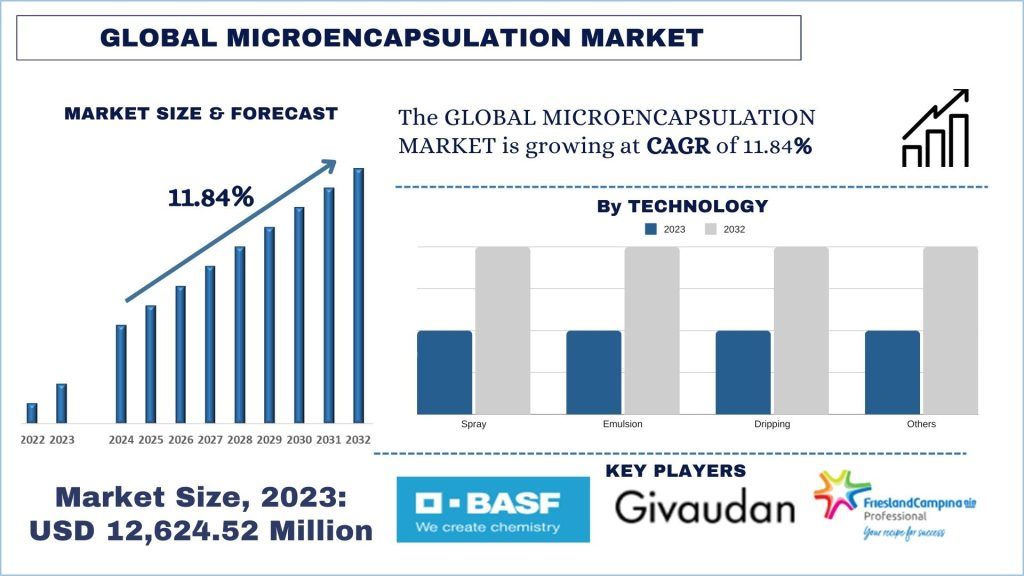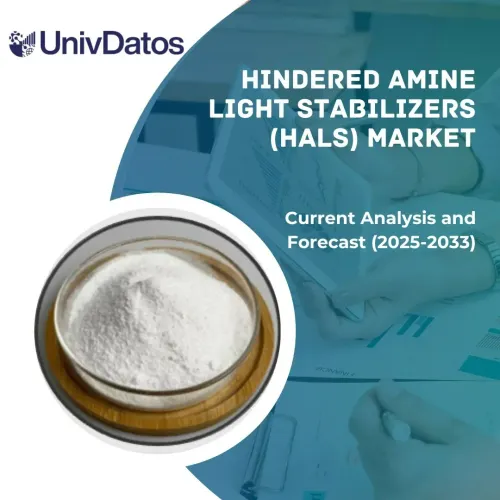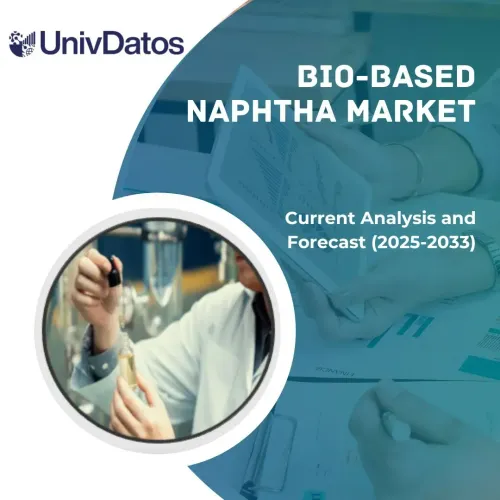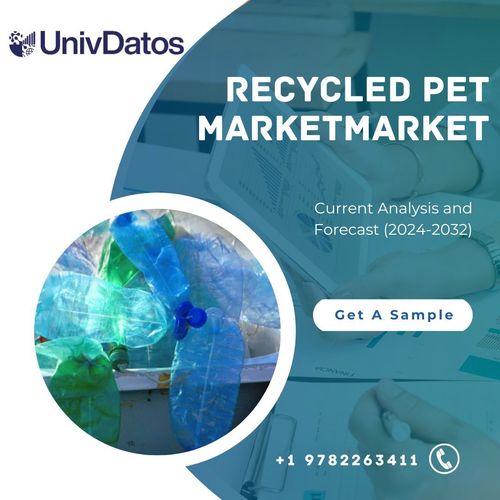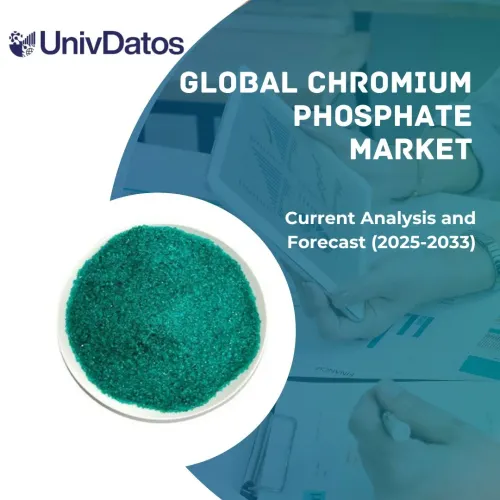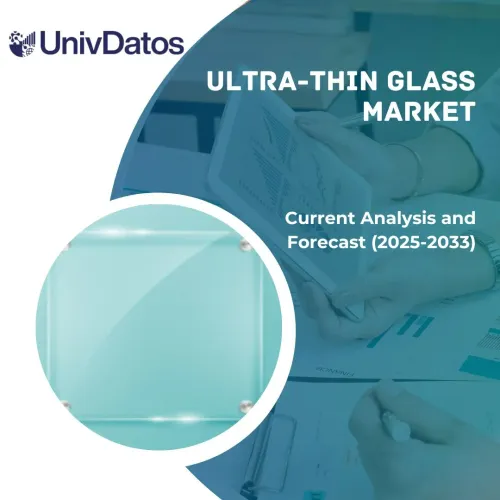- Accueil
- À propos de nous
- Industrie
- Services
- Lecture
- Contactez-nous
Marché de la microencapsulation : analyse actuelle et prévisions (2024-2032)
Accent sur la technologie (pulvérisation, émulsion, goutte-à-goutte et autres) ; matériau d'enrobage (gommes, glucides, protéines, lipides et autres) ; application (produits pharmaceutiques, aliments et boissons, soins personnels et domestiques, produits agrochimiques, autres) ; et région/pays
Taille et prévisions du marché de la microencapsulation
Le marché de la microencapsulation était évalué à 12 624,52 millions USD en 2023 et devrait croître à un TCAC robuste d'environ 11,84 % au cours de la période de prévision (2024-2032), en raison de l'application croissante dans l'industrie pharmaceutique, de la demande croissante de produits de soins personnels et domestiques due à l'urbanisation croissante, à la population active croissante et à la demande de produits durables et respectueux de l'environnement.
Analyse du marché de la microencapsulation
La microencapsulation a été considérée comme un outil efficace pour développer de nouveaux aliments avec de multiples fonctionnalités. Cette technologie a été utilisée dans des produits commerciaux tels que les jus, les chocolats, les viandes et la volaille. Par exemple, en janvier 2023, la société allemande BASF SE, spécialisée dans la microencapsulation des vitamines, a mis en œuvre un nouveau procédé de microencapsulation pour les poudres de vitamine A et D utilisées pour la fortification de la farine et du sucre, offrant la plus grande stabilité possible. BASF a récemment lancé de la vitamine A sans BHT pour améliorer la fortification de la farine et du sucre. Il s'agit d'une poudre de palmitate de vitamine A pour une application directe ou par le biais de prémélanges. La comparaison technique révèle que cette poudre de vitamine A sans BHT a une stabilité plus élevée que les autres poudres de vitamine A sans BHT disponibles sur le marché. De plus, grâce au développement de l'industrie pharmaceutique, la microencapsulation a une fonction importante en tant que moyen d'administration contrôlée et ciblée des médicaments, ainsi que pour masquer le goût et l'odeur amers et augmenter la stabilité des médicaments. Par conséquent, ce marché s'est multiplié au cours des deux dernières années et devrait poursuivre la même tendance.
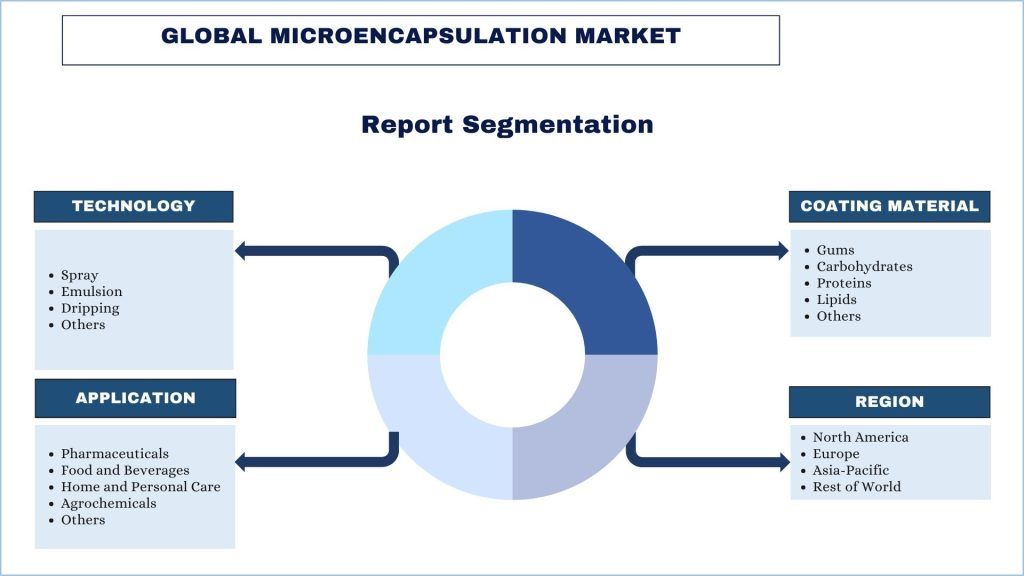
Tendances du marché de la microencapsulation
Demande croissante de microencapsulation pour le masquage des saveurs
Le besoin croissant de microencapsulation pour le masquage des saveurs afin d'améliorer le goût, la protection et la libération efficace des ingrédients actifs. L'application pratique la plus connue de la microencapsulation est le masquage des saveurs, qui est un aspect essentiel de l'administration des médicaments, car de nombreux médicaments ont des goûts ou des odeurs désagréables qui peuvent dissuader les patients de les prendre. Grâce au processus d'encapsulation, le goût amer et/ou l'odeur désagréable de l'API peuvent être bien dissimulés à l'intérieur d'un matériau d'enrobage, améliorant ainsi l'appétence et l'acceptabilité du médicament. Cela a incité les sociétés pharmaceutiques à développer des formulations microencapsulées ciblant les enfants. Par exemple, Novartis a lancé une suspension d'antibiotique microencapsulée avec un meilleur goût, ce qui signifie que les enfants peuvent prendre leurs médicaments facilement.
L'Amérique du Nord domine le marché de la microencapsulation
Le marché de la microencapsulation en Amérique du Nord aura la plus grande taille de marché au cours de la période de prévision en raison de facteurs tels que la présence d'un secteur pharmaceutique bien développé, d'une industrie agroalimentaire en croissance, d'investissements élevés en R&D et de réglementations favorables. Cette région, en particulier l'Amérique du Nord, abrite de grandes sociétés pharmaceutiques et biotechnologiques qui s'appuient sur des outils et des systèmes de microencapsulation pour l'administration de médicaments, l'amélioration du goût et la stabilité. Par exemple, Pfizer, Merck et Amgen ont développé des médicaments microencapsulés pour un meilleur taux de dissolution, une libération prolongée et un approvisionnement ciblé des tissus ou des organes. Cependant, l'un des moteurs du développement de la technique complexe de microencapsulation est le régime réglementaire sain de la région ainsi que l'approbation stricte de la FDA américaine et de Santé Canada. L'Amérique du Nord est également une région en développement dynamique de l'industrie agroalimentaire, dans laquelle Nestlé, PepsiCo et Kraft Heinz ont dépensé des millions pour développer des technologies de microencapsulation afin de produire de nouveaux types d'aliments fonctionnels, de boissons améliorées et de nutracéutiques. Par exemple, Nestlé l'a appliqué pour préparer des produits de café au goût et à l'odeur améliorés, tandis que PepsiCo a appliqué la technique pour enrober des probiotiques dans des jus pour la protection et la libération chronométrée. L'évolution des préférences des clients vers des aliments de meilleure qualité et plus pratiques continue de pousser le secteur agroalimentaire de la région vers l'adoption des technologies de microencapsulation.
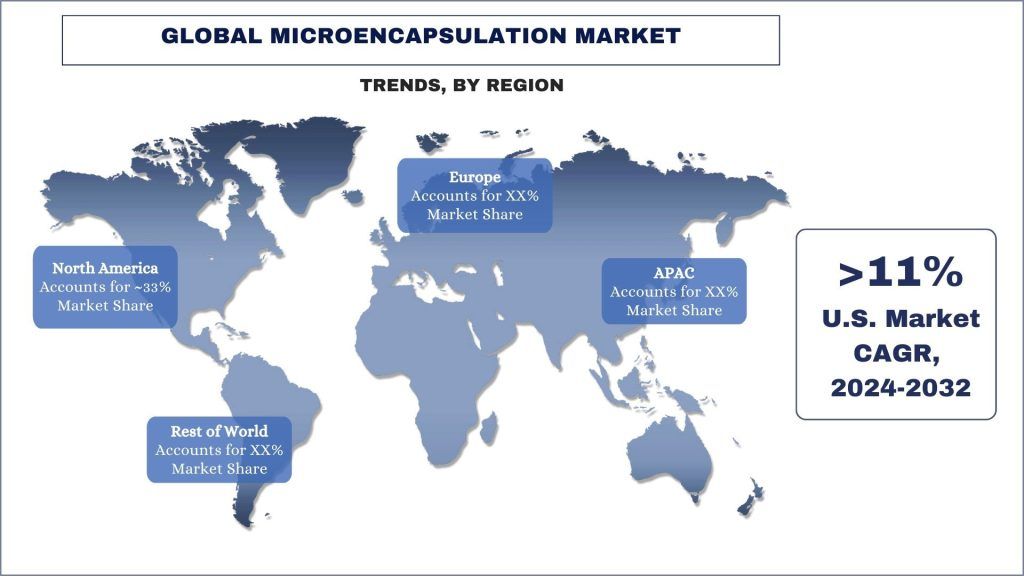
Aperçu de l'industrie de la microencapsulation
Le marché de la microencapsulation est concurrentiel et concentré, avec peu d'acteurs mondiaux et internationaux. Les principaux acteurs adoptent différentes stratégies de croissance pour renforcer leur présence sur le marché, telles que des partenariats, des accords, des collaborations, des lancements de nouveaux produits, des expansions géographiques et des fusions et acquisitions. Certains des principaux acteurs opérant sur le marché sont BASF SE, Givaudan, Royal FrieslandCampina, Cargill, Incorporated, International Flavors & Fragrances Inc., Sensient Technologies Corporation, Ingredion, Balchem Corp, Firmenich SA et Microtek Laboratories, Inc.
Actualités du marché de la microencapsulation
En mars 2024, FrieslandCampina Ingredients lance Biotis DHA FlexP 15 et Biotis DHA FlexP 20, deux nouvelles poudres de DHA (acide docosahexaénoïque) microencapsulées à base d'algues pour la santé du cerveau, adaptées aux formulations végétaliennes et végétariennes conçues pour les aliments, les boissons et les compléments alimentaires. Le DHA est un acide gras oméga-3 lié à la santé du cerveau, des yeux et cardiovasculaire.
En juillet 2022, Givaudan Active Beauty fait progresser la technologie de microencapsulation en dévoilant Spherulite™ HA Ultimate, un ingrédient actif durable pour le bien-vieillir capable de délivrer de l'acide hyaluronique (AH) de haut poids moléculaire (HPM) aux couches profondes de la peau grâce à la technologie de vectorisation. Dédié aux soins des lèvres, Spherulite™ HA Ultimate démontre des bénéfices repulpants instantanés et à long terme significatifs. L'AH est largement utilisé dans les solutions de bien-vieillir car il joue un rôle majeur dans le maintien de l'hydratation et du repulpage de la peau.
Couverture du rapport sur le marché de la microencapsulation
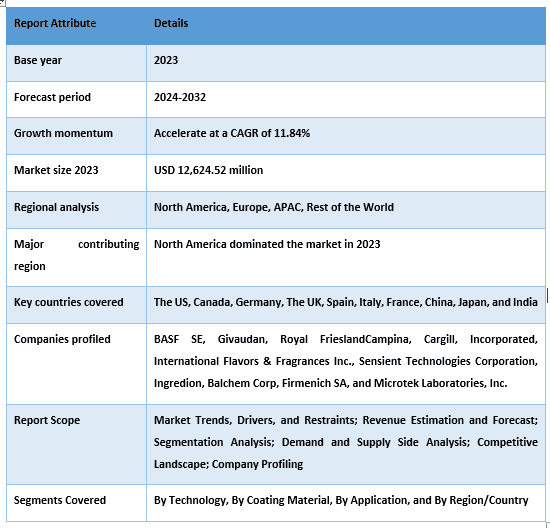
Raisons d'acheter ce rapport :
- L'étude comprend une analyse de dimensionnement et de prévision du marché validée par des experts clés de l'industrie authentifiés.
- Le rapport présente un bref aperçu de la performance globale de l'industrie en un coup d'œil.
- Le rapport couvre une analyse approfondie des principaux acteurs de l'industrie, en mettant l'accent sur les principales données financières, les portefeuilles de produits, les stratégies d'expansion et les développements récents.
- Examen détaillé des moteurs, des contraintes, des principales tendances et des opportunités prévalant dans l'industrie.
- L'étude couvre de manière exhaustive le marché à travers différents segments.
- Analyse approfondie du marché au niveau régional de l'industrie.
Options de personnalisation :
Le marché mondial de la microencapsulation peut être personnalisé davantage en fonction des exigences ou de tout autre segment de marché. En outre, UMI comprend que vous pouvez avoir vos propres besoins commerciaux, n'hésitez donc pas à nous contacter pour obtenir un rapport qui correspond parfaitement à vos besoins.
Table des matières
Méthodologie de recherche pour l'analyse du marché de la microencapsulation (2024-2032)
L'analyse du marché historique, l'estimation du marché actuel et la prévision du marché futur du marché mondial de la microencapsulation ont été les trois principales étapes entreprises pour créer et analyser l'adoption de la microencapsulation dans les principales régions du monde. Des recherches secondaires exhaustives ont été menées pour collecter les chiffres historiques du marché et estimer la taille actuelle du marché. Deuxièmement, pour valider ces informations, de nombreuses conclusions et hypothèses ont été prises en considération. De plus, des entretiens primaires exhaustifs ont également été menés, avec des experts de l'industrie tout au long de la chaîne de valeur du marché mondial de la microencapsulation. Après l'hypothèse et la validation des chiffres du marché par le biais d'entretiens primaires, nous avons employé une approche descendante/ascendante pour prévoir la taille complète du marché. Par la suite, des méthodes de répartition du marché et de triangulation des données ont été adoptées pour estimer et analyser la taille du marché des segments et des sous-segments de l'industrie concernée. La méthodologie détaillée est expliquée ci-dessous :
Analyse de la taille historique du marché
Étape 1 : étude approfondie des sources secondaires :
Une étude secondaire détaillée a été menée pour obtenir la taille historique du marché de la microencapsulation par le biais de sources internes de l'entreprise telles que les rapports annuels et les états financiers, les présentations de performances, les communiqués de presse, etc., et de sources externes, y compris les revues, les actualités et les articles, les publications gouvernementales, les publications des concurrents, les rapports sectoriels, les bases de données tierces et d'autres publications crédibles.
Étape 2 : segmentation du marché :
Après avoir obtenu la taille historique du marché de la microencapsulation, nous avons mené une analyse secondaire détaillée pour collecter des informations historiques sur le marché et des parts pour différents segments et sous-segments pour les principales régions. Les principaux segments sont inclus dans le rapport, notamment la technologie, le matériau d'enrobage et l'application. Des analyses supplémentaires au niveau des pays ont été menées pour évaluer l'adoption globale des modèles de test dans cette région.
Étape 3 : analyse factorielle :
Après avoir acquis la taille historique du marché des différents segments et sous-segments, nous avons mené une analyse factorielle détaillée pour estimer la taille actuelle du marché de la microencapsulation. De plus, nous avons mené une analyse factorielle en utilisant des variables dépendantes et indépendantes telles que la technologie, le matériau d'enrobage et l'application du marché de la microencapsulation. Une analyse approfondie a été menée pour les scénarios de l'offre et de la demande en tenant compte des principaux partenariats, fusions et acquisitions, de l'expansion des activités et des lancements de produits dans le secteur du marché de la microencapsulation dans le monde entier.
Estimation et prévision de la taille actuelle du marché
Dimensionnement du marché actuel :Sur la base d'informations exploitables tirées des 3 étapes ci-dessus, nous sommes parvenus à la taille actuelle du marché, aux principaux acteurs du marché mondial de la microencapsulation et aux parts de marché des segments. Toutes les parts de pourcentage requises, les divisions et les ventilations du marché ont été déterminées en utilisant l'approche secondaire susmentionnée et ont été vérifiées par le biais d'entretiens primaires.
Estimation et prévision :Pour l'estimation et les prévisions du marché, des pondérations ont été attribuées aux différents facteurs, notamment les moteurs et les tendances, les contraintes et les opportunités disponibles pour les parties prenantes. Après avoir analysé ces facteurs, des techniques de prévision pertinentes, c'est-à-dire l'approche descendante/ascendante, ont été appliquées pour parvenir aux prévisions du marché pour 2032 pour différents segments et sous-segments sur les principaux marchés du monde. La méthodologie de recherche adoptée pour estimer la taille du marché englobe :
- La taille du marché de l'industrie, en termes de revenus (USD) et le taux d'adoption du marché de la microencapsulation sur les principaux marchés au niveau national
- Toutes les parts de pourcentage, les divisions et les ventilations des segments et des sous-segments de marché
- Les principaux acteurs du marché mondial de la microencapsulation en termes de produits proposés. De plus, les stratégies de croissance adoptées par ces acteurs pour concurrencer sur le marché en forte croissance.
Validation de la taille et de la part de marché
Recherche primaire :Des entretiens approfondis ont été menés avec les principaux leaders d'opinion (KOL), notamment les cadres de haut niveau (CXO/VP, responsable des ventes, responsable du marketing, responsable opérationnel, responsable régional, responsable national, etc.) dans les principales régions. Les résultats de la recherche primaire ont ensuite été résumés et une analyse statistique a été effectuée pour prouver l'hypothèse énoncée. Les contributions de la recherche primaire ont été consolidées avec les conclusions secondaires, transformant ainsi l'information en informations exploitables.
Répartition des principaux participants dans différentes régions
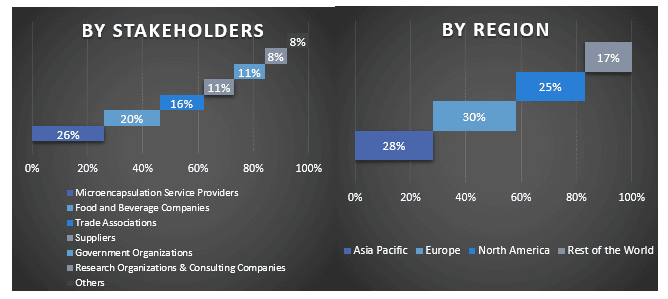
Ingénierie de marché
La technique de triangulation des données a été employée pour compléter l'estimation globale du marché et pour parvenir à des chiffres statistiques précis pour chaque segment et sous-segment du marché mondial de la microencapsulation. Les données ont été divisées en plusieurs segments et sous-segments après l'étude de divers paramètres et tendances dans les domaines de la technologie, du matériau d'enrobage et de l'application sur le marché mondial de la microencapsulation.
L'objectif principal de l'étude du marché mondial de la microencapsulation
Les tendances actuelles et futures du marché mondial de la microencapsulation ont été identifiées dans l'étude. Les investisseurs peuvent obtenir des informations stratégiques pour baser leur discrétion en matière d'investissements sur l'analyse qualitative et quantitative effectuée dans l'étude. Les tendances actuelles et futures du marché ont déterminé l'attractivité globale du marché au niveau régional, offrant une plateforme aux participants industriels pour exploiter le marché inexploité afin de bénéficier d'un avantage de premier arrivé. D'autres objectifs quantitatifs des études comprennent :
- Analyser la taille actuelle et prévue du marché de la microencapsulation en termes de valeur (USD). De plus, analyser la taille actuelle et prévue du marché des différents segments et sous-segments.
- Les segments étudiés comprennent les domaines de la technologie, du matériau d'enrobage et de l'application.
- Définir et analyser le cadre réglementaire de la microencapsulation
- Analyser la chaîne de valeur impliquée avec la présence de divers intermédiaires, ainsi qu'analyser les comportements des clients et des concurrents de l'industrie.
- Analyser la taille actuelle et prévue du marché de la microencapsulation pour la région majeure.
- Les principaux pays des régions étudiées dans le rapport comprennent l'Asie-Pacifique, l'Europe, l'Amérique du Nord et le Reste du monde
- Profils d'entreprises du marché de la microencapsulation et stratégies de croissance adoptées par les acteurs du marché pour soutenir le marché en croissance rapide.
- Analyse approfondie au niveau régional de l'industrie
Questions Fréquemment Posées FAQ
Q1 : Quelle est la taille actuelle du marché et le potentiel de croissance du marché de la microencapsulation ?
Q2 : Quels sont les facteurs moteurs de la croissance du marché de la microencapsulation ?
Q3 : Quel segment détient la plus grande part de marché de la microencapsulation par technologie ?
Q4 : Quelles sont les technologies et tendances émergentes sur le marché de la microencapsulation ?
Q5 : Quelle région dominera le marché de la microencapsulation ?
Connexes Rapports
Les clients qui ont acheté cet article ont également acheté

